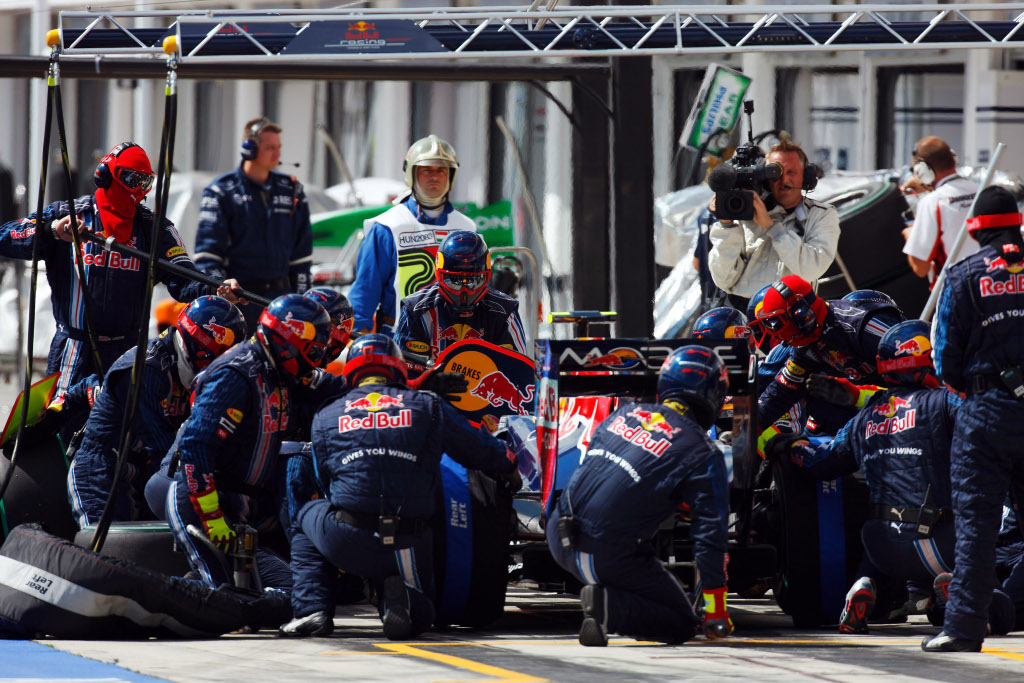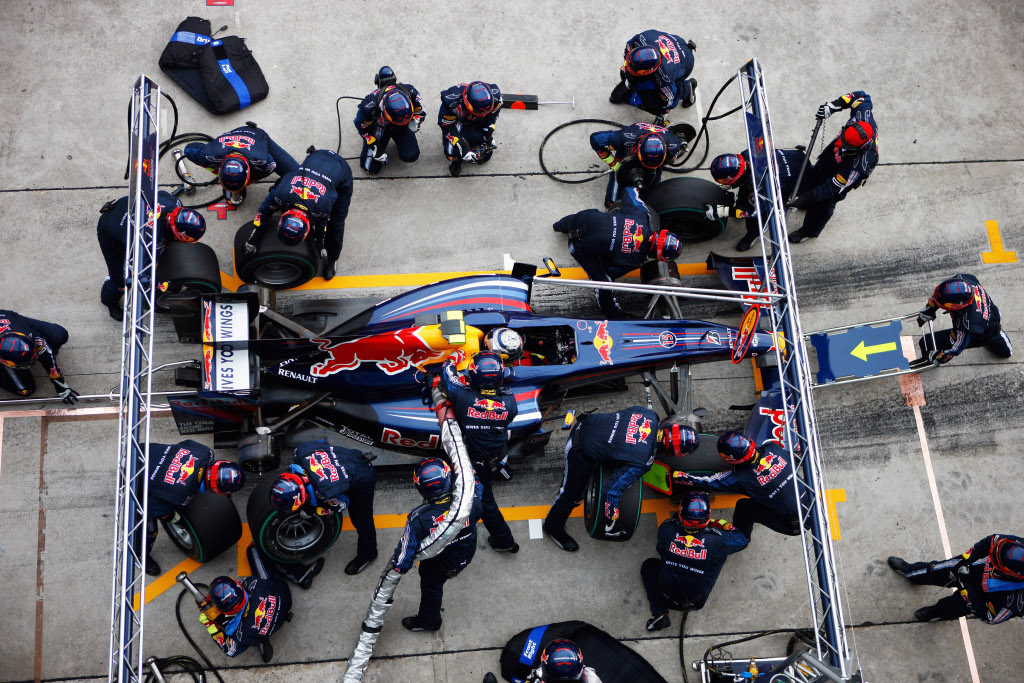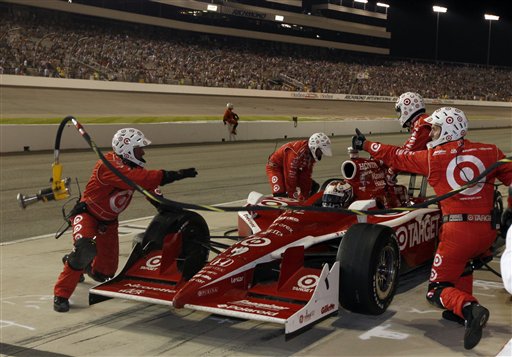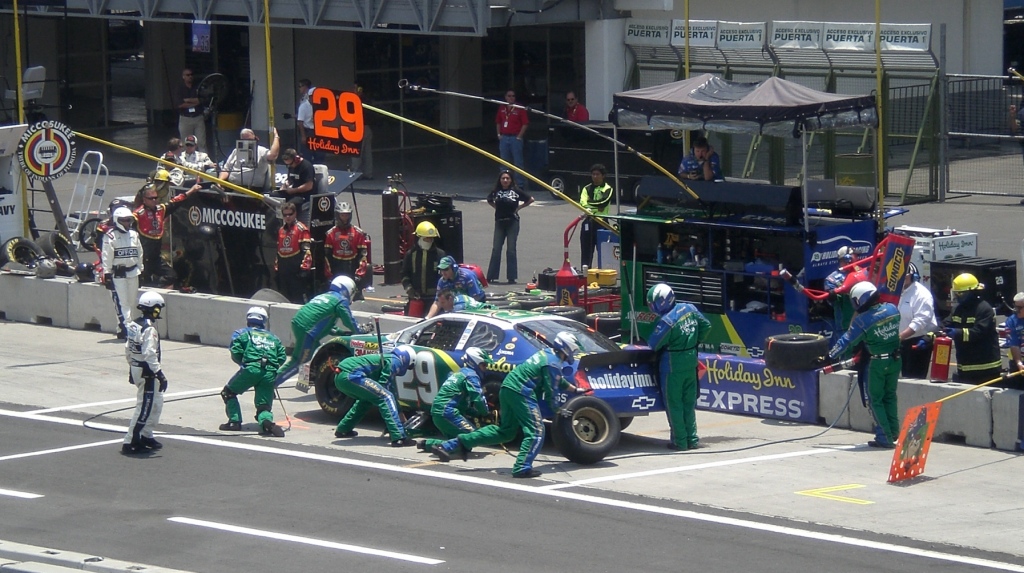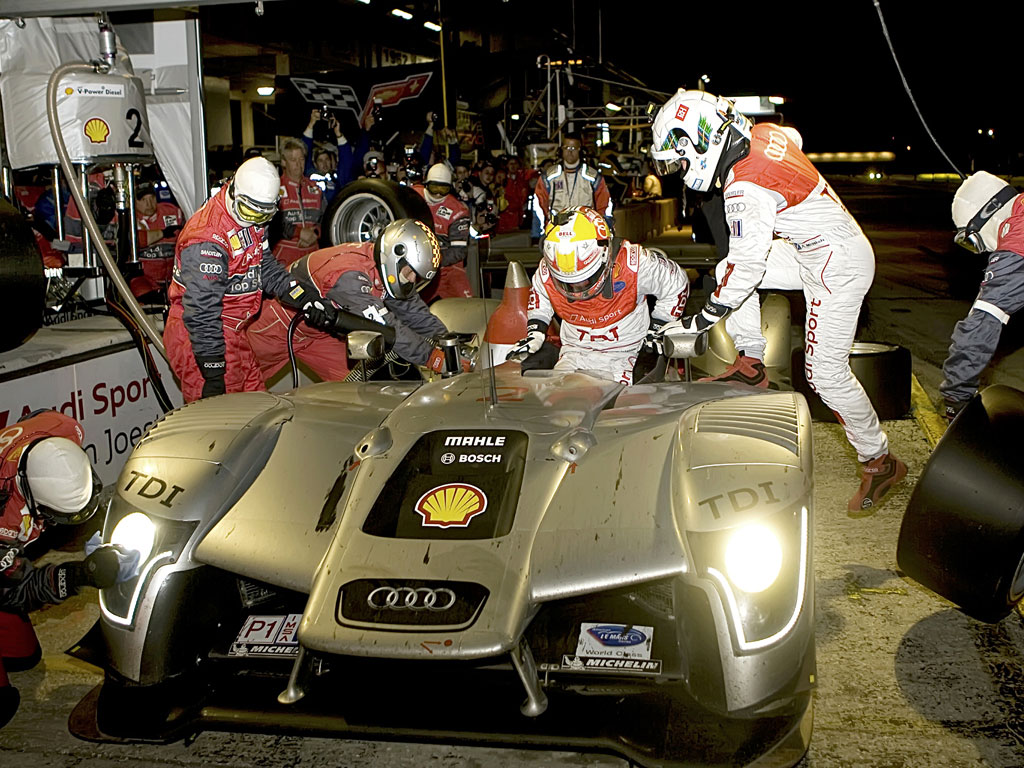Today we're going to focus on how pit crews do their jobs in the multitude of forms of motor racing there are in the world. It's a well-known fact that winning a race in any series worldwide involves not only some incredible driving skills from the competitor inside the cockpit, but also a team effort.
One could argue that the proportion in which the pit crew helps and guides a driver through winning a race differs from series to series. And we're not to contradict that! Obviously, a tire change or refueling process will count less in any endurance race – like the 24 Hours of Le Mans – where seconds are not so important in terms of overall result, than in Formula One, NASCAR or Indy Car.
It usually takes around 10-to-20 seconds to change tires and refuel a car in most racing series, although some time reports may differ depending on the mechanics involved in the pit stop process. So we're going to take each important series independently, as the sporting regulations differ from one sanctioning body to another.
Who else are we going to start with if not the Formula One series? The pinnacle of motorsports – as its mostly known by race pundits worldwide – is one of the few championships in which the number of pit men is not mentioned in any rule book by the International Automobile Federation (FIA). Basically, if the car entering the pits needs more work than initially projected, a bigger amount of mechanics will come to assist the pit stop process.
The number of men who will most definitely make the pit stop every time a car enters the pit lane are 19. This is arguably the highest amount of mechanics assisting a pit stop from all racing series worldwide. And the way they are distributed around the car is this:
Apart from those mandatory mechanics – mandatory by their function within a pit stop, rather than a certain regulation in the FIA rule book – there are some situations in which several other members of a crew step in and help the driver during a pit stop. If a driver damages his car's front wing during a race incidents, two or even three mechanics will be added to the aforementioned ones, removing the old wing and installing the new one. In addition, one or more mechanics may be used to remove debris from radiator air intakes, clean the driver's visor, change the angle of the front wing or proceed to resolving any other problem might come up prior to the pit stop.
As far as the Formula One counterpart series Indy Racing League (Indy Car) is concerned, this is where it gets tricky. Unlike in the Great Circle, the North American racing series have clear rules regarding the number of mechanics to attend a pit stop during the races. Apart from the Indy Car championship, such rules are also enforced inside the NASCAR series.
First, let's focus on the Indy Car Series. Here, the number of mechanics allowed to work during a pit stop in terms of tire change and refuel is 6. Unlike Formula One, some clear regulations regarding the pit stop are stated in the championship's rule book from the very beginning of the year.
There is only one mechanic per wheel during a pit stop in the IRL, meaning an obvious total of four. However, only 3 of those 4 mechanics have a predefined position in the pit stall, while the 4th will take his position only after the car will have stopped. This 4th mechanic is the one sitting in the rear of the car, on the far side of the pit wall – right or left, depending on the pit lane of each circuit – because the rules of the Indy Car clearly state that the car should not run over the hose used by the rear mechanics to control the wrench for removing and installing the tires.
Apart from those 4 mechanics, a 5th member of the crew fits a vent hose into the socket of the engine cowling, aiming to vent out the air from the fuel tank and also activate the car's built-in pneumatic jacks. This operation actually takes place before the 4th member of the crew takes his place in the tire-changing process, as only after the pneumatic jacks are activated the 4 tire changers can actually proceed to do their jobs.
After the first hose was coupled to the car, a second hose, the fuel one this time, is attached by the 6th and last mechanic to the fuel tank.
After all 6 men have completed their job, the mechanic who used to change the right-hand front tire gives the driver the go-ahead to exit the pit stall. However, as compared to Formula One, the Indy Car pit crew does not benefit from the presence of a starter in the rear of the car. However, if the car does stop while in the pits, the 6-man crew is allowed to push the car and help it return to the track.
Just like in Formula One, however, the mechanics assisting a pit stop may be more than just 6. Although not allowed to cross the pit wall, a 7th mechanic may use a pressurized hose and wash up any excess of ethanol that remained after the refueling process.
As far as NASCAR is concerned, there is also a limitation on the number of mechanics permitted to help out during a pit stop. The NASCAR teams use a maximum of 7/8 men to change tires and refuel, with the overall time of a pit stop depending on the number of tires to be changed. Some teams choose to change only 2 tires, while some go for the all-tire strategy, depending on the timing of the stop and strategy of the team (also the level of tire wear, of course).
Unlike in Formula One, there are no less than 5 wheel nuts for each of the 4 tires on the car. Also, there are only 2 mechanics proceeding to tire change, one for the front side and one for the rear. In addition to those two mechanics, there are also 2 more tire carriers who have different roles within a pit stop. First of all, they bring the new tires and hand them to the tire changers, and secondly they take care of the used tires and make sure they don't roll out outside the team's pit stall.
There is also a jackman involved in the pit stop process, who uses a regular jack to lift a car on the side where the two tire changers operate. He and the two mechanics who change the tires may share functions during the pit stops, meaning he can also help with the removal of the old tires once the wheel nuts are taken off.
Finally there are two mechanics who are taking care of the refueling process, something some of you might find particularly interesting in NASCAR. While only one individual is needed to complete the refueling process during a pit stop, as he uses two cans of gasoline, another mechanic (named the catch can man) uses a catch can to prevent fuel overflow during the process. This mechanic attaches the aforementioned catch can to the car's overflow vent and, when the can is full, signals the completion of the pit stop.
Of course, there is also an 8th and final member of the pit crew, who can only be used in the second part of the race, who takes care of routine business during the stop: clean the windshield, make slight adjustments to the car or stuff like that. He is also called the utility man, so it's quite obvious what his function within the team is.
Some interesting rules regarding the pit crew in NASCAR are those concerning the pushing of a car in case it stops during the refueling/tire changing process. When the jackman releases the jack for the second time, that means the driver is good to go. However, if his car stops, the 7/8 members of his crew are allowed to push it for as long as 3 pit stall lengths through the pit lane.
In the DTM, some kind of NASCAR counterpart in European competitions – although there is a huge amount of technical regulations that differentiate these two racing series – things get even simpler. There are only 10 people attending a pit stop during these race, with the distribution of roles between those mechanics quite logical. Two mechanics operate tire change for each of the 4 wheels of the car – which is performed at the same time – while the other two perform refueling and lollipop duties respectively.
Yes, we know what you're going to say, performing a pit stop in endurance racing is easier than in usual road racing competitions, but bear in mind the fact that several other factors come into play when doing it.
For example, the pit crew has to take care of more than just refueling and equipping the car with a new set of tires. Basically, when a car enters the pit for refuel/tire change/driver change, the whole stop looks more like a service session rather than a performance against the clock. The mechanics will also have to change several aerodynamic parts of the car – depending on the track conditions, weather and other such factors – replace mechanical parts such as brake pads, parts of suspension and do a routine check of the car, in addition to refueling it and changing its tires.
While the 24 Hours of Le Mans organizers stipulate that a maximum of 5 mechanics are allowed to attend a pit stop, the North American counterpart of the European Le Mans Series, the ALMS, use only 4 people to do it. Basically, we're talking about two tire changers who operate on only one side of the car, two tire carriers (whose role we have already covered in the Indy Car section) and a mechanic who refuels the car.
It's most important to note the fact that the refueling process always takes place first. Only after the fuel is inserted in the fuel tank, the other members of the team are allowed to step in and commence their job. In addition, when the car comes in, the engine is automatically stopped before any operation is to start.
In the American Le Mans Series, while one man refuels the car, the other three share roles in changing the tires – they replace and carry the tires as they want – while a 5th and a 6th mechanic may assist in case drivers change (helping the new driver get into the car, fasten his seat belts, assisting him with a multitude of helmet connections, etc) or as a firefighter (in case a fire is set off). However, neither of those two members of the team are allowed to do any mechanical work on the car during the pit stop.
One could argue that the proportion in which the pit crew helps and guides a driver through winning a race differs from series to series. And we're not to contradict that! Obviously, a tire change or refueling process will count less in any endurance race – like the 24 Hours of Le Mans – where seconds are not so important in terms of overall result, than in Formula One, NASCAR or Indy Car.
It usually takes around 10-to-20 seconds to change tires and refuel a car in most racing series, although some time reports may differ depending on the mechanics involved in the pit stop process. So we're going to take each important series independently, as the sporting regulations differ from one sanctioning body to another.
Who else are we going to start with if not the Formula One series? The pinnacle of motorsports – as its mostly known by race pundits worldwide – is one of the few championships in which the number of pit men is not mentioned in any rule book by the International Automobile Federation (FIA). Basically, if the car entering the pits needs more work than initially projected, a bigger amount of mechanics will come to assist the pit stop process.
The number of men who will most definitely make the pit stop every time a car enters the pit lane are 19. This is arguably the highest amount of mechanics assisting a pit stop from all racing series worldwide. And the way they are distributed around the car is this:
- three mechanics are distributed to each of the 4 wheels of the car. One is to use a pneumatic wrench to remove the wheel's lug nut, one is to take off the used tire and the 3rd is to reinstall the new tire. After that, the first guy steps back in and fixes the tire with the single lug nut.
- two mechanics make use of lever-type jacks to lift the car during the pit stop, in order to help their colleagues proceed to the usual tire change. One is placed in the front of the car, while obviously the second is placed in the rear.
- a starter man will always sit in the rear of the car and be ready to use his starter tool in case the car becomes stalled during the pit top process. That way, only a limited amount of time will be lost in case that happens. Most of the times, however, the starter man doesn't get to do his job during the pit stop.
- a fuel man has to attach and remove the refueling hose to/from the car's fuel receptacle during the pit stop, while helped by one or two assistants to carry the fuel hose. However, these mechanics will no longer be needed in Formula One next season, as the FIA recently introduced a refueling ban during races.
- the lollipop man has probably the toughest job in the world when it comes to a pit stop procedure. First, he signals the driver where exactly his pit crew is placed via a “Pit Stop” sign, and afterwards shows the driver the “Brake” sign reminding him to press the brakes while the other mechanics do their job. He then reverses the sign into “1st Gear”, reminding the driver to switch to 1st gear once the tire changers' job is complete. But the hardest part is to signal the driver when to leave the garage, as he has to maintain perfect coordination between all 18 mechanics involved in the pit stop. At the exact time everybody completed their job, the lollipop man signals the driver to leave the pits. If something goes wrong, well... we have witnessed plenty of situations when a car left the pit with the fuel hose still attached to it, or the wheel was not correctly installed at one of the wheels.
Apart from those mandatory mechanics – mandatory by their function within a pit stop, rather than a certain regulation in the FIA rule book – there are some situations in which several other members of a crew step in and help the driver during a pit stop. If a driver damages his car's front wing during a race incidents, two or even three mechanics will be added to the aforementioned ones, removing the old wing and installing the new one. In addition, one or more mechanics may be used to remove debris from radiator air intakes, clean the driver's visor, change the angle of the front wing or proceed to resolving any other problem might come up prior to the pit stop.
As far as the Formula One counterpart series Indy Racing League (Indy Car) is concerned, this is where it gets tricky. Unlike in the Great Circle, the North American racing series have clear rules regarding the number of mechanics to attend a pit stop during the races. Apart from the Indy Car championship, such rules are also enforced inside the NASCAR series.
First, let's focus on the Indy Car Series. Here, the number of mechanics allowed to work during a pit stop in terms of tire change and refuel is 6. Unlike Formula One, some clear regulations regarding the pit stop are stated in the championship's rule book from the very beginning of the year.
There is only one mechanic per wheel during a pit stop in the IRL, meaning an obvious total of four. However, only 3 of those 4 mechanics have a predefined position in the pit stall, while the 4th will take his position only after the car will have stopped. This 4th mechanic is the one sitting in the rear of the car, on the far side of the pit wall – right or left, depending on the pit lane of each circuit – because the rules of the Indy Car clearly state that the car should not run over the hose used by the rear mechanics to control the wrench for removing and installing the tires.
Apart from those 4 mechanics, a 5th member of the crew fits a vent hose into the socket of the engine cowling, aiming to vent out the air from the fuel tank and also activate the car's built-in pneumatic jacks. This operation actually takes place before the 4th member of the crew takes his place in the tire-changing process, as only after the pneumatic jacks are activated the 4 tire changers can actually proceed to do their jobs.
After the first hose was coupled to the car, a second hose, the fuel one this time, is attached by the 6th and last mechanic to the fuel tank.
After all 6 men have completed their job, the mechanic who used to change the right-hand front tire gives the driver the go-ahead to exit the pit stall. However, as compared to Formula One, the Indy Car pit crew does not benefit from the presence of a starter in the rear of the car. However, if the car does stop while in the pits, the 6-man crew is allowed to push the car and help it return to the track.
Just like in Formula One, however, the mechanics assisting a pit stop may be more than just 6. Although not allowed to cross the pit wall, a 7th mechanic may use a pressurized hose and wash up any excess of ethanol that remained after the refueling process.
As far as NASCAR is concerned, there is also a limitation on the number of mechanics permitted to help out during a pit stop. The NASCAR teams use a maximum of 7/8 men to change tires and refuel, with the overall time of a pit stop depending on the number of tires to be changed. Some teams choose to change only 2 tires, while some go for the all-tire strategy, depending on the timing of the stop and strategy of the team (also the level of tire wear, of course).
Unlike in Formula One, there are no less than 5 wheel nuts for each of the 4 tires on the car. Also, there are only 2 mechanics proceeding to tire change, one for the front side and one for the rear. In addition to those two mechanics, there are also 2 more tire carriers who have different roles within a pit stop. First of all, they bring the new tires and hand them to the tire changers, and secondly they take care of the used tires and make sure they don't roll out outside the team's pit stall.
There is also a jackman involved in the pit stop process, who uses a regular jack to lift a car on the side where the two tire changers operate. He and the two mechanics who change the tires may share functions during the pit stops, meaning he can also help with the removal of the old tires once the wheel nuts are taken off.
Finally there are two mechanics who are taking care of the refueling process, something some of you might find particularly interesting in NASCAR. While only one individual is needed to complete the refueling process during a pit stop, as he uses two cans of gasoline, another mechanic (named the catch can man) uses a catch can to prevent fuel overflow during the process. This mechanic attaches the aforementioned catch can to the car's overflow vent and, when the can is full, signals the completion of the pit stop.
Of course, there is also an 8th and final member of the pit crew, who can only be used in the second part of the race, who takes care of routine business during the stop: clean the windshield, make slight adjustments to the car or stuff like that. He is also called the utility man, so it's quite obvious what his function within the team is.
Some interesting rules regarding the pit crew in NASCAR are those concerning the pushing of a car in case it stops during the refueling/tire changing process. When the jackman releases the jack for the second time, that means the driver is good to go. However, if his car stops, the 7/8 members of his crew are allowed to push it for as long as 3 pit stall lengths through the pit lane.
In the DTM, some kind of NASCAR counterpart in European competitions – although there is a huge amount of technical regulations that differentiate these two racing series – things get even simpler. There are only 10 people attending a pit stop during these race, with the distribution of roles between those mechanics quite logical. Two mechanics operate tire change for each of the 4 wheels of the car – which is performed at the same time – while the other two perform refueling and lollipop duties respectively.
Yes, we know what you're going to say, performing a pit stop in endurance racing is easier than in usual road racing competitions, but bear in mind the fact that several other factors come into play when doing it.
For example, the pit crew has to take care of more than just refueling and equipping the car with a new set of tires. Basically, when a car enters the pit for refuel/tire change/driver change, the whole stop looks more like a service session rather than a performance against the clock. The mechanics will also have to change several aerodynamic parts of the car – depending on the track conditions, weather and other such factors – replace mechanical parts such as brake pads, parts of suspension and do a routine check of the car, in addition to refueling it and changing its tires.
While the 24 Hours of Le Mans organizers stipulate that a maximum of 5 mechanics are allowed to attend a pit stop, the North American counterpart of the European Le Mans Series, the ALMS, use only 4 people to do it. Basically, we're talking about two tire changers who operate on only one side of the car, two tire carriers (whose role we have already covered in the Indy Car section) and a mechanic who refuels the car.
It's most important to note the fact that the refueling process always takes place first. Only after the fuel is inserted in the fuel tank, the other members of the team are allowed to step in and commence their job. In addition, when the car comes in, the engine is automatically stopped before any operation is to start.
In the American Le Mans Series, while one man refuels the car, the other three share roles in changing the tires – they replace and carry the tires as they want – while a 5th and a 6th mechanic may assist in case drivers change (helping the new driver get into the car, fasten his seat belts, assisting him with a multitude of helmet connections, etc) or as a firefighter (in case a fire is set off). However, neither of those two members of the team are allowed to do any mechanical work on the car during the pit stop.
